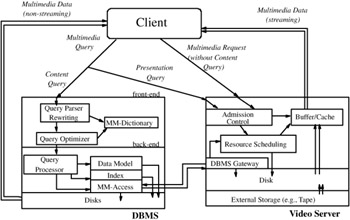Chapter 4: Multimedia Database Management Systems
|
| < Day Day Up > |
|
Overview
A multimedia database management system (MMDBMS) must provide a suitable environment for using and managing multimedia data. Therefore, it must support the various multimedia data types in addition to providing facilities for traditional DBMS functions like database creation, data modeling, data retrieval, data access and organization, and data independence.
The special nature of multimedia data also makes it important to support new and special functions. These include management of huge volumes of multimedia data and effective storage and delivery management in a multimedia storage server. The storage server may be part of the DBMS, but it may also be an individual physical component. In this case, to guarantee efficiency, the DBMS must be closely connected to the storage server.
In addition, a MMDBMS must provide the means for efficient information indexing and retrieval, support conceptual multimedia data models, and manage the query optimization and processing issues. MMDBMSs must also address problems specific to distributed databases, such as distributed query processing.
Network issues such as limited bandwidth and network delays are important considerations, as they would have adverse effects on the quality of service. Unlike in traditional DBMSs, data replication is often not encouraged in a distributed MMDBMS because of the large data volume exchanged. In this context, for simple pull applications (i.e., the client requests data from the server), the Client-Server (C-S) computing model is considered suitable for distributed MMDBMSs. [1] More complex multimedia applications might require a video server and MMDBMS architecture, which is more dynamic (Chapter 5 deals with this issue in detail).
Exhibit 4.1 shows the components that a general-purpose MMDBMS and video server (as an example of a multimedia storage server) may provide. The scenario chosen is a simple retrieval one. A client issues a multimedia query to the server system. The query is first analyzed, and the content-based query part is separated from the presentation part. The content-query goes to the MMDBS, as the presentation-related parts, that is, results that may be played or shown in specified composition, are submitted to the video server.
Exhibit 4.1: General-purpose multimedia database management system and video server architecture.

Let us concentrate on the content-query first. The query is parsed first, possible redundancy in the formulation is detected, and the query is rewritten. Then, the query optimizer prepares an execution plan for the query processor. The query processor searches for the content that corresponds to the query specification. This search process may involve complex operator processing mechanisms (like execution of multimedia joins, group by, etc.). Then, the MMDBMS informs the video server about the multimedia data to be delivered. If the MMDBMS and the video server are tightly coupled, for example, through a DBMS gateway available on the video server, no further query submission to the video server is necessary, and the data is then delivered, possibly by being streamed from the video server to the client. If this close connection is not available, the database results are returned to the client and may be submitted to the video server later.
Thus, the client may contact the video server directly, without involving the MMDBMS, or after having obtained the metadata on the videos from the MMDBMS. These queries may impose certain presentation constraints on the video server; for example, if two videos are demanded, the second video will be streamed 5 seconds after the end of the first one. The query is first analyzed by the admission control. The task of the admission control is to find an optimal schedule of the videos requested such that neither the presentation constraints nor the network and server constraints are violated. The latter assumes that the server has enough available resources (size of the buffer, disk bandwidth, etc.) to sustain the requirements of all actually supported video streams. Thus, for each newly submitted query, the admission control checks whether it can be admitted or not. On admission, the required resources for the video delivery have been reserved in advance. The resource-scheduling module is now responsible for managing the resources for all concurrently served video streams. Buffering is an important issue in video server resource management and is used to amortize different resource bandwidths; for instance, between disk, memory, and network.
Throughout this chapter the effect of MPEG-7 and MPEG-21 on the design and implementation process of a MMDBMS is discussed. Selected use cases are presented, as well as links to current projects. This chapter is organized as follows. Section 4.1 describes the indexing process and its effect on multimedia data modeling and highlights some of the important projects currently in progress. This is followed by a discussion in Section 4.2 of broadly used index structures to accelerate access to features extracted during the indexing process. Then, in Section 4.3, we sketch how a conceptual multimedia data model can be implemented in a MMDBMS and how it can be communicated in a distributed system. We also introduce SQL (Structured Query Language)/MM here and compare MPEG-7 with the object type hierarchy introduced in SQL/MM. Section 4.4 gives an overview of content-based retrieval systems. Section 4.5 introduces multimedia query languages (e.g., those used in Oracle interMedia and SQL/MM), query optimization, and processing and links them to content-based retrieval. Section 4.6 gives an overview of MMDBMS product (an historical sketch and an overview of actual developments) and details some selected products.
[1]Lu, G., Multimedia Database Management Systems, Artech House, 1999.
|
| < Day Day Up > |
|
EAN: 2147483647
Pages: 77